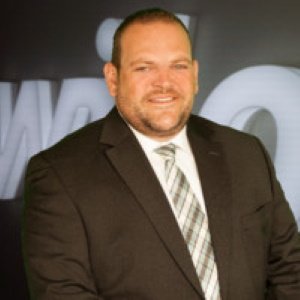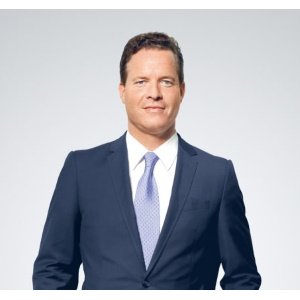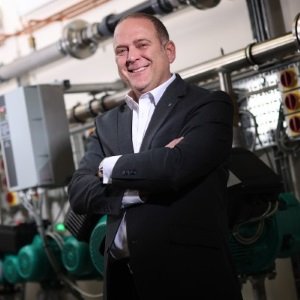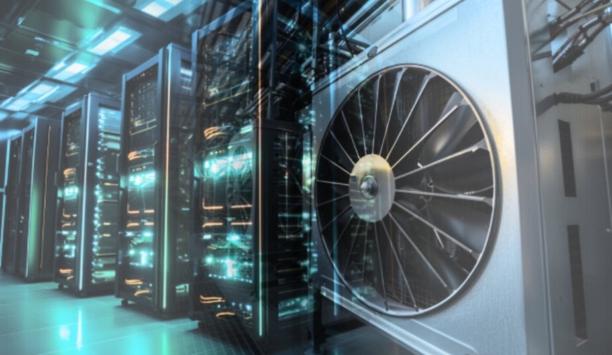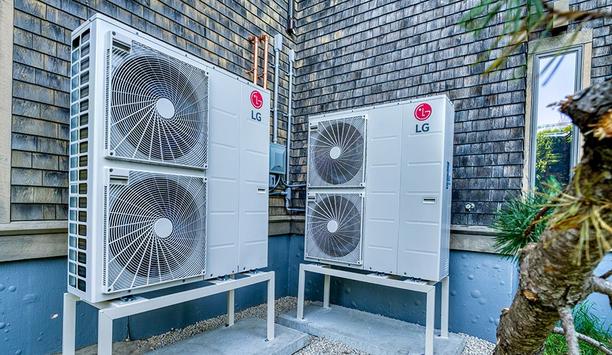Wilo USA - Experts & Thought Leaders
Latest Wilo USA news & announcements
With building heating and cooling performance crucial for achieving Net Zero, Wilo has unveiled its latest innovation, Sinum. The automatic de-aeration system optimizes building services by eliminating trapped air and ensuring proper pressurization. The Sinum has been designed for suitable operation across a host of applications, including buildings – such as schools and hospitals – as well as the nation’s exponentially increasing number of data centres. Improves heating and cooling The Wilo Sinum also automatically tops up systems to maintain pressure The unit, which consists of a pump unit and pressureless expansion vessel, improves heating and cooling of buildings by delivering constant pressurisation. It does this through automatically eliminating trapped air (often known as ‘degassing’ amongst the industry) and solid particles within sealed heating systems and chilled water cooling systems. The Wilo Sinum also automatically tops up systems to maintain pressure. It offers continuous degassing under three selectable operation modes and can be integrated into building management systems. It also improves the efficiency of the system over traditional degassing systems, as well as sitting on a much smaller footprint. This helps to reduce building costs and free up valuable space for other purposes. Making heating and cooling energy efficient Jason Cox, sales director at Wilo, said: “Heating and cooling processes are widely known to account for a substantial portion of global energy consumption and emissions.” “It’s estimated that half of the world's final energy consumption goes towards heating and cooling, and this sector is accountable for over 40% of global energy-related carbon dioxide emissions. Given this, it’s imperative that new buildings and their heating and cooling systems are as efficient as possible.” “This is where the Wilo Sinum comes in. By removing trapped air and dirt from water, it means pumps that move this water around the system do not have to work as hard. Ultimately, energy consumption is lowered as a result.” Easy installation and Efficient operation The Wilo Sinum features a host of technology to allow for easy installation and good ongoing operation The Wilo Sinum features a host of technology to allow for easy installation and good ongoing operation. This includes an intuitive digital display that shows error messages and a self-learning microprocessor, with a modular design for installation flexibility. The pressureless expansion vessels supplied with the Sinum come in a variety of sizes, including 100 - 1,000 litres in accordance with EN 13831, and 1,200 - 10,000 litres in accordance with AD2000. Meanwhile, the Sinum’s pump unit comes as a ‘mono’ or ‘double’ unit, depending on the needs and size of the system chosen. Other features of Wilo Sinum “The Wilo Sinum is the perfect solution when standard equipment with a diaphragm expansion tank reaches its limit,” said Jason. “It features a range of advanced technology, including volumetric controls and auto-topping up and replenishing of water systems, offering a long service life and easy maintenance,” concluded Jason Cox.
Following a record year for its residential building services division, Wilo has announced the appointment of Dan Williams to its business development team. Dan Williams Dan Williams, a former Assistant Manager at a national plumbers’ merchant and a plumbing and heating engineer by trade, has joined Wilo as a Business Development Representative, to continue growing the pump manufacturer’s presence in the UK. With ten years of experience in the HVAC industry, Dan will be covering the Midlands, Wales, and Southwest regions to help grow the brand amongst installers, independent merchants, and national distributors. Free product training and knowledge Dan Williams will be traveling across the regions he covers to set up trade mornings at merchants Based in Wales, Dan Williams will be traveling across the regions he covers to set up trade mornings at merchants. At these sessions, Dan will be providing free product training and knowledge to installers and merchants’ trade counter staff, as well as showcasing how Wilo’s pumps can increase the efficiency of plumbing and heating systems. WiloXperts’ loyalty scheme Alongside the training, Dan Williams will also be helping installers sign up and use Wilo’s recently launched ‘WiloXperts’ loyalty scheme. WiloXperts allows installers to earn points that can be traded in for Amazon gift vouchers every time they purchase a qualifying Wilo pump. For a limited time, installers who do sign up through Dan and upload their first qualifying invoice can earn an additional 500 points, which can be traded in for a £5 Amazon gift voucher. raise awareness On his appointment, Dan Williams said, “It’s great to be a part of the Wilo family. Since joining, I’ve been able to see first-hand the innovation that goes into Wilo’s range of pumps, and I’m excited to raise awareness about all the technology that Wilo is bringing to market." He adds, “I started in my career by installing these products, and then through to selling them, while I was behind the counter at merchants. For me, this is the next natural evolution as I can appreciate all the different sides, and I will be bringing my knowledge and experience to help installers and merchants in their roles.” residential building services The appointment comes as Wilo UK has had one of the strongest years in its history Dan Williams joins Wilo’s other Business Development Representatives, Oli Thurlow and Paula Plover, who cover the North and Southeast respectively, and means Wilo serves merchants and installers across England, Scotland, Wales, and Northern Ireland. The appointment comes as Wilo UK has had one of the strongest years in its history for its residential building services division. simpler installation and commissioning Andy Thompson, National Sales Manager – Plumbing and Heating at Wilo UK, said, “We’re thrilled to have someone of Dan’s caliber join our team." He adds, "Quite simply, with his background, he’s seen it and done it, and now it’s all about spreading the awareness of how installers and merchants can continually improve in what they do and the products they install and recommend." save energy Andy Thompson continues, “Dan joins Oli and Paula and we’re already seeing some very strong results from having our team on the ground, visiting our distribution partners, and sharing their knowledge. While we’ve seen others go down a digital route, we feel there is no substitute for hands-on training and face-to-face conversation." He concludes, "We’ll soon be bringing even more of that as we’re equipping the team with new training rigs that will allow them to demonstrate exactly how our products work to save energy and enable simpler installation and commissioning.”
Following revelations that the Office for Product Safety and Standards (OPSS) found over 85% of domestic heating circulators it inspected last year were non-compliant, distributors and installers are being urged to look out for ‘fake’ pumps as they could pose a safety hazard to consumers. The callout by Wilo, the efficiency-first pump manufacturer, leads on from the OPSS’ Delivery report 2022-2023, in which the UK Government department also disclosed that it had de-listed 38 domestic heating circulation pumps from sale. Wilo Urges to Check for Fake pumps The manufacturer strongly advises that if it is ‘too good to be true’, then it is most likely non-compliant Now, Wilo is urging distributors and installers to think twice, and check pumps hold the right certifications and markings, before stocking or installing them in homes and heating systems. The manufacturer strongly advises that if it is ‘too good to be true’, then it is most likely non-compliant and wants the industry to spot the warning signs. Lee Tebbatt, Managing Director of Wilo UK, said: “We’ve seen a swathe of non-compliant pumps make their way onto the market, and in many cases, they are manufactured to look like the real deal. We welcome the work the OPSS is doing to weed out these fake heating circulation pumps, but while the problem is still ongoing, it’s imperative that distributors, merchants and installers know how to spot a fake." Non-compliant circulator pumps Lee Tebbatt added: “First and foremost, it is about safety and security for the public. Non-compliant circulator pumps may use low-quality motors, components and materials, and if they have not been tested and accredited correctly, they could break down earlier than expected, cost more energy and money to run, and even be dangerous." He continues, "Secondly, if found to be selling non-compliant pumps, not only could the products be de-listed by the OPSS and stock taken away to be destroyed, but there is a chance that there could be further legal ramifications or prosecution.” Three checks of Wilo There are three checks Wilo is urging distributors and installers to make on domestic heating circulation pumps, which are to: 1. Check the pump’s CE Marking 2. Check that the pump comes from a reputable pump manufacturer 3. Be cautious if the pump is significantly cheaper than similar market alternatives. OPSS’ attention last year The scale of the problem was first brought to the OPSS’ attention last year by the BPMA The scale of the problem was first brought to the OPSS’ attention last year by the British Pump Manufacturers Association (BPMA), of which Lee Tebbatt sits on the board as Vice President. The BPMA and Wilo first uncovered that an estimated 100,000 non-compliant domestic heating circulation pumps being manufactured abroad were making their way onto the UK market annually. “Between Wilo, the BPMA, the OPSS and other pump manufacturers, we are working hard to end the problem of non-compliant pumps entering the UK market,” said Lee Tebbatt, adding “It is vital that the supply chain and installers also work with us to ensure these products are not unknowingly sold on or fitted in peoples’ homes.” Integrity of the pump industry Wayne Rose, CEO of the BPMA, said: “The British Pump Manufacturers Association (BPMA) is deeply concerned by the recent announcement from the Office for Product Safety and Standards regarding the prevalence of non-compliant circulator pumps in the UK market. The findings raise serious questions about the efficacy of current regulatory measures governing circulator pumps. Non-compliant products not only offer significant reductions in energy efficiency values but also undermine the integrity of the pump industry and erode trust in regulatory processes. Wayne Rose adds, “In response to these developments, the BPMA reaffirms its commitment to promoting excellence and compliance within the pump industry. The association stands ready to collaborate with the OPSS and other relevant bodies to develop and implement measures that enhance product safety and integrity.” To help distributors and installers even further, Wilo has created a FAQs page on its website about non-compliant pumps.
Insights & Opinions from thought leaders at Wilo USA
With ongoing efforts from governments across the globe to reduce carbon emissions and with an ever greater focus on sustainability, it is vital that the HVAC sector does its part in becoming more environmentally conscious. And, while there have been steps to become more sustainable, there is a huge amount that still needs to be done to make sure that many of the targets that have been set are attainable. In buildings, both large and small, industrial heating accounts for roughly two thirds of industrial energy demand and around a fifth of global energy consumption. Figures like this show the need to have efficient and environmentally-friendly HVAC equipment in place to make the crucial steps towards reducing the contributions these systems make to our carbon footprint. High energy consumption in construction sector A 2019 report by The International Environment Agency (IEA) showed that the buildings and construction sectors combined were responsible for over 30% of global energy consumption and nearly 40% of carbon emissions. This is indicative of the steps the sector needs to take to play its role in a more eco-friendly society, some of which are already underway. However, much more needs to be done if the UK is to reach its goal of reaching net zero carbon emissions by 2050. As we envisage what a post-COVID world might look like, businesses and governments are continuing to put sustainability and lower carbon emissions at the forefront of their planning and the HVAC sector is certainly no exception. But with change in the sector a daunting prospect, decision-makers often don’t know where to start. Smart Technology use in HVAC systems Smart HVAC uses sensors that integrate with a building’s automation system With the constant growth and greater deployment of smart technologies within the HVAC sector, this is certainly a way that systems can become more efficient. Smart HVAC uses sensors that integrate with a building’s automation system. These sensors then collect information about conditions throughout the building. Heat waves are now a far more common occurrence in the United Kingdom. The Met Office estimates they are up to 30 times more likely and will be a bi-annual occurrence by 2050. It is important that any uptake in HVAC usage doesn’t lead to a drastic increase in emission generation. This is one of the areas where smart systems will become crucial. Many scientists have been unequivocal in their sentiment that heat waves are a cause of greater emissions and expect temperature records in the UK and Europe to be broken more regularly, so sites will need to be equipped to handle these conditions. Regulating temperature with hand-held devices With wireless systems now much more commonplace, temperatures can be controlled easily from hand-held devices. With these new technologies, those managing the systems can also benefit from remote monitoring and maintenance, reducing the need to travel to the site for yet another environmental incentive. To accompany the smart systems, equipment including smart thermostats can be installed to maximize HVAC efficiency. Other smart systems available to businesses include smart furnaces and air conditioning units that are far easier to operate than their traditional counterparts. Reducing unnecessary ventilation While global temperatures continue to rise, air conditioning usage has increased and has contributed to greater levels of energy usage. A huge amount of needless emissions are generated by unnecessary ventilation, contributing heavily to heat loss and overall energy wastage. Recirculation of air is a traditionally lower energy cost method of retaining heat and keeping emissions low, however, we must be mindful of the risks associated with recirculating air. The risk of circulating diseases is negated somewhat with heat recovery ventilation, which both removes the risk of disease spreading and improves energy consumption. Efficiency performance of new AC units Air conditioning units in particular contribute significantly to a building’s energy consumption Air conditioning units in particular contribute significantly to a building’s energy consumption, equating to 10% of the UK’s electricity consumption and as such it is important that we bear in mind ways to counteract the emissions this creates. Global energy demand for air conditioning units is expected to triple by 2050, as temperatures continue to rise year on year. The efficiency performance of new air conditioning units will be the key, when it comes to ensuring that escalating demand does not equate to greater emissions. Another issue for suppliers and manufacturers to address is differing rates of consumption for AC units in different countries, with units sold in Japan and the EU typically more efficient than those found in China and the US. Modularization Modular HVACs have also become increasingly popular in recent years. Modular HVACs are responsible for heating, cooling and distributing air through an entire building, with their increase in popularity largely down to their greater levels of energy efficiency, cost effectiveness, flexibility and substantial ease of installation and maintenance. Modular HVACs can be tailored specifically for workspaces and they often allow work to be done on the systems without disturbing the workforce, achieved primarily through rooftop placement. Commercial workspaces are larger and often require differing needs to residential properties and can cater to a wide range of the specific requirements of work and commercial spaces. As we strive for lower carbon emissions, it seems that this trend will continue and will become a key area in reducing emissions that HVACs have traditionally generated. System maintenance and training To meet government and industry requirements, many new buildings will require HVAC systems that can be maintained simply in order to perform in a more energy efficient way. Many companies are looking at ways to become climate neutral and significantly reduce their footprint Many companies are looking at ways to become climate neutral and significantly reduce their footprint. Companies are following the likes of German-based company, Wilo Group, who have announced they are committing to sustainable manufacturing by developing a new carbon neutral plant and HQ in the next few years. Lowering carbon footprint As we continue to move towards an ever more environmentally conscious society, it will be of paramount importance for companies, governments and the public to think about ways in which we can lower carbon emissions. Smart technologies will certainly be at the forefront of this, negating many needless journeys and making it easier for industries to adjust settings and tackle issues remotely. Greater levels of training will help equip us with the tools to make sure we are best placed to reduce emissions and be more sustainable as a result. While the steps outlined above do show some progress and measures we can take, there is far more that we can do as a sector to significantly reduce HVAC’s carbon footprint and once we have moved beyond the impact of the COVID-19 pandemic, this will surely be at the front of industry leader minds.
From A To L: Your A2L Transition Guide
DownloadLeveraging Radiant And Hydronics To Help Achieve Decarbonization Goals
DownloadSealed Connectors In Harsh Environments
DownloadPowering And Cooling Next Generation Data Centers
DownloadDebunking Myths To Promote A Bright Future For Heat Pumps
Download























